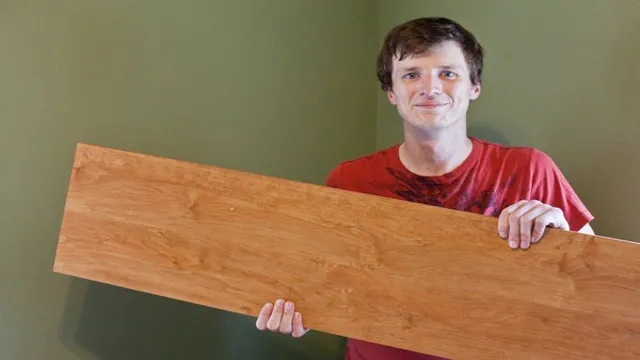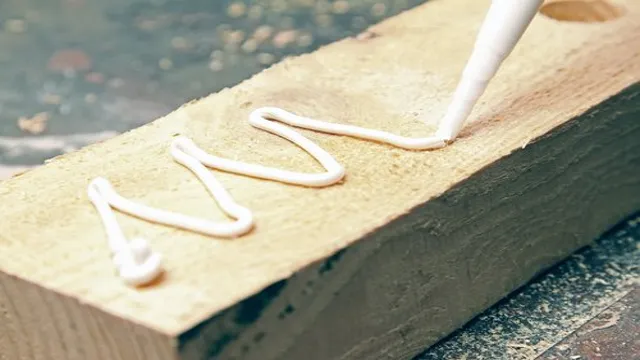If you’ve been working with treated lumber lately, you may be wondering if it can be glued effectively. Treated lumber is treated with chemicals to prevent rot and insects, which can make it difficult to glue. However, with the right technique and adhesive, gluing treated lumber can be done effectively.
In this blog post, we’ll discuss everything you need to know about gluing treated lumber, including which adhesives to use, how to prepare the wood, and tips for ensuring a strong bond. So if you’re planning to work with treated lumber, keep reading to learn more about how to glue it effectively!
Understanding Treated Lumber
Treated lumber is wood that has been chemically altered to resist rot and decay, making it a popular choice for outdoor projects such as decks, fences, and landscaping. While treated lumber is strong and durable, many people wonder if it can be glued. The answer is yes, treated lumber can be glued, but it requires the right type of adhesive.
Regular wood glue will not work on treated lumber as the chemicals in the wood can react with the adhesive and weaken the bond. Instead, it is recommended to use a waterproof adhesive specifically designed for treated lumber, such as epoxy or polyurethane. These adhesives are resistant to moisture and chemicals, making them ideal for outdoor use.
When gluing treated lumber, it is also important to ensure the surfaces are clean and free of any dirt, oil, or debris that could inhibit the bond. With the right adhesive and proper preparation, treated lumber can be successfully glued for a secure and long-lasting hold.
Explanation of Treated Lumber
Treated lumber, also known as pressure-treated wood, is wood that has undergone a process to protect it from rot, decay, and insect damage. This is achieved by placing the wood in a chamber and subjecting it to high pressure and chemicals that prevent these issues from occurring. The chemicals used in the process will vary depending on the intended use of the wood and the region it is being sold in, but they typically include copper, arsenic, and chromium.
While treated lumber is more durable than untreated wood, it is important to take precautions when handling it, such as wearing gloves and washing your hands thoroughly. It is also not recommended to burn treated lumber, as the fumes can be harmful. Overall, treated lumber is a great option for outdoor projects that will be exposed to the elements and pests, providing a long-lasting and reliable solution.

Types of Treated Lumber
Treated lumber refers to any wood that has undergone a chemical process to make it more durable and resistant to decay, insects, and other outdoor elements. There are various types of treated lumber available on the market, each with different levels of chemicals and treatments. One of the most common types is pressure-treated lumber, which involves placing the wood in a pressure chamber and impregnating it with chemicals such as copper, chromium, and arsenic.
Another type is kiln-dried after treatment (KDAT) lumber, which is dried in a kiln after being treated to reduce its moisture content and prevent warping. Other types of treated lumber include fire-resistant lumber, borate-treated lumber, and cedar-tone lumber. It’s important to choose the right type of treated lumber depending on your project and the specific outdoor conditions it will be subjected to, such as moisture levels and exposure to sunlight.
By using treated lumber, you can ensure your outdoor projects last longer and require less maintenance over time.
Gluing Treated Lumber
Can you glue treated lumber? The short answer is yes, you can. However, it is important to note that treated lumber contains chemicals that can interfere with the adhesion of glue. For this reason, it is recommended that you use a specific type of adhesive known as an epoxy glue.
Epoxy glue is able to bond with the chemicals found in treated lumber, making it the ideal choice for gluing this type of wood. Another option is to rough up the surface of the lumber with sandpaper or a wire brush, as this can help improve the adhesive bond. It is also important to ensure that the surfaces being glued are clean and dry, as any dirt or moisture can negatively impact the bond of the adhesive.
So, while gluing treated lumber is possible, it is important to take the necessary precautions to ensure the bond is strong and durable.
Factors to Consider
When it comes to gluing treated lumber, there are a few factors that need to be considered to ensure a successful project. Treated lumber has been chemically treated to resist rot and insect damage, which can make it more difficult to glue properly. One important factor to consider is the type of glue that should be used.
Not all glues are suitable for treated lumber, so it’s important to use a waterproof and weather-resistant adhesive. Additionally, it’s important to properly prepare the surface of the wood before gluing. This may involve sanding or wiping down the surface to remove any dirt, debris, or moisture.
Finally, it’s important to clamp the pieces together tightly while the glue dries to create a strong bond. By following these steps and using the right glue, it’s possible to successfully glue treated lumber and complete your project with confidence.
Types of Glue to Use
When it comes to gluing treated lumber, it’s important to choose the right type of glue to ensure a strong bond. One option is polyurethane glue, also known as Gorilla Glue, which creates a chemical reaction when exposed to moisture, resulting in a strong and durable bond. Another option is epoxy glue, which is a two-part adhesive that also creates a strong bond.
However, it’s important to note that not all types of treated lumber are compatible with epoxy, so it’s important to read the manufacturer’s instructions before using it. Lastly, if you’re working with pressure-treated lumber, it’s recommended to use a construction adhesive specifically designed for that type of wood, such as PL Premium or Liquid Nails Subfloor Adhesive. These adhesives are formulated to work with the chemicals used in pressure treating and will provide a reliable bond.
Preparation Process
Gluing treated lumber is a straightforward process if you prepare the wood properly. First, make sure the surface of the lumber is clean and dry. Use a sanding block to smooth down any rough spots or bumps and wipe off any dust with a damp cloth.
If you’re gluing two pieces of lumber together, apply a thin layer of glue to both surfaces, making sure to spread it evenly with a roller or brush. Then, clamp the pieces together tightly for at least an hour to allow the glue to set. Remember to choose a glue that is suitable for use with treated wood, as regular wood glue may not adhere correctly.
By taking these steps, you can achieve a strong, reliable bond that will ensure your project lasts for years to come.
Best Practices for Gluing Treated Lumber
Yes, you can glue treated lumber, but it’s important to follow best practices to ensure a strong and lasting bond. Firstly, it’s important to let the treated lumber dry fully before attempting to glue it. This can take anywhere from a few days to a few weeks depending on the type of treatment.
Secondly, make sure to use an adhesive specifically designed for use with treated lumber, as traditional wood glue may not adhere properly. When applying the glue, use a generous amount and press the pieces firmly together, using clamps if necessary until the glue has dried completely. Overall, with patience and attention to detail, gluing treated lumber can be done successfully for a secure and durable construction project.
Safety Measures
If you’re working with treated lumber, it’s important to take extra precautions when gluing it. A common issue with treated lumber is that the chemicals used to preserve it can interfere with the bond of the glue, leading to weakened joints and potential hazards. To ensure the best possible results, it’s important to start by choosing the correct type of glue for the job.
Epoxy is often a good choice for treated lumber, as it is less affected by moisture and chemical exposure than other types of glue. However, it’s important to follow directions carefully and allow ample time for the glue to cure. Additionally, be sure to sand the surfaces to be glued before application, and use clamps to keep the joint secure while the glue dries.
By following these best practices, you can ensure a strong, safe bond for your treated lumber projects.
Tips for Maximum Adhesion
When it comes to gluing treated lumber, there are a few tips to keep in mind to get the best possible adhesion. First and foremost, it’s important to make sure that the surface of the wood is clean and dry before applying any adhesive. This may require sanding or wiping down with a clean cloth.
Additionally, it’s important to choose an adhesive that is specifically designed for use with treated lumber. Look for a product that is labeled as “weatherproof” or “waterproof” to ensure maximum durability. It’s also a good idea to apply the adhesive liberally and use clamps or weights to hold the pieces in place while the adhesive sets.
By taking these steps, you can ensure that your treated lumber project will be as strong and durable as possible.
Conclusion
In the end, the question of whether or not you can glue treated lumber comes down to one simple answer: it depends. While some types of treated lumber can be successfully glued, others may require special adhesives or pre-treatment. So if you’re planning to embark on a DIY project with treated lumber, it’s important to do your research and choose the right materials and techniques for the job.
After all, if you want your finished product to stick together (and stay together!), using the right glue is key. As they say, a little bit of preparation goes a long way in the world of woodworking. Happy gluing!”
FAQs
Is it safe to use glue on treated lumber?
Yes, it is safe to use glue on treated lumber. However, you should ensure that the glue you are using is compatible with the chemicals used in the lumber treatment process.
What type of glue works best with treated lumber?
Polyurethane glue is the most effective glue for treated lumber. It provides a strong bond and is resistant to water and moisture.
Can you use regular wood glue on treated lumber?
Regular wood glue may not provide a strong enough bond on treated lumber. It is recommended to use a polyurethane glue specifically designed for treated lumber.
How long should I wait before gluing treated lumber?
It is recommended to wait 24-48 hours after treatment before gluing treated lumber. This allows the wood to fully dry and acclimate to its new environment.
Can I use nails instead of glue on treated lumber?
Nails can be used in addition to glue on treated lumber, but they may not provide as strong of a hold as glue. Moreover, nails can cause splitting or cracking in treated lumber, especially near the edges.
Is it necessary to clamp treated lumber when using glue?
Clamping treated lumber can help ensure a strong bond between the wood and the adhesive. However, if the glue is a polyurethane adhesive, clamping is not necessary as the adhesive will expand to fill gaps.
Should I sand treated lumber before gluing?
Yes, sanding treated lumber before gluing can help the adhesive adhere better to the wood surface. Sand with a fine-grit sandpaper to avoid damage to the wood surface.






